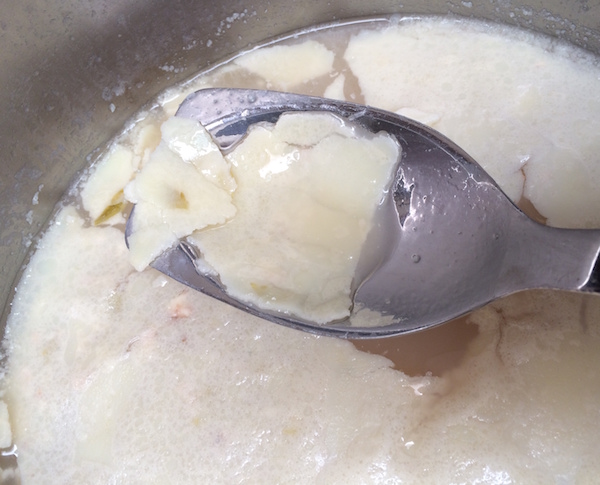How to Skim Fat From Your Soup, Stew or Sauce
Skimming fat does not require standing over the pot and carefully and slowly running your spoon across the top of the soup, stew or sauce. You’ve probably already realized that hot fat is hard to catch or you wouldn’t be on this page.
Below are the few simple steps for how to skim fat in order to easily and cleanly skim fat from any recipe that includes some fatty meat products.

How To Skim Fat
How to Skim Fat From Your Soup, Stew or Sauce
- After making your recipe, allow the pot to cool and then place the pot into the fridge, preferably overnight. *Be sure to read the caution below.
- Before using, grab a spoon (there are special spoons to skim fat, like the one pictured that make it a breeze or just use a spatula or whatever you’ve got). Place the spoon just under the top layer that has formed across the pot and gently lift the solidified fat right off and discard.
- To serve: Heat the soup (or whatever you’re making) up right in the same pan, bringing it to a boil first (for safety in case you left it out of the refrigerator too long) and then simmering until serving time.

*CAUTION: Soup must be cooled before placing it into the refrigerator. If not, your refrigerator temperature will spike with the introduction of the hot soup. A large pot of soup can take up to 20 hours to cool down to 40°F and cause the fridge temperature to rise up as high as 70°F! During this same time nearby foods, especially highly perishable ones like milk, will also rise to unsafe temperatures. Since perishable foods should not sit out of the fridge for longer than two hours, and soup is still very hot after two hours, we have a few recommendations to reduce the risk food spoilage. Since soup is best in cool weather, the best way to cool your soup before placing it into the refrigerator is to place your covered pot on your doorstep to cool for a few hours before placing it into the fridge. If it’s not that cold outside, then place the pot into a sink of ice water. This allows both the contents and the pan to safely cool without making your refrigerator work overtime to adjust to the sudden addition of heat. When cool, place the pot onto the top shelf of your fridge (*remember: heat rises).
P.S. You can also easily freeze soup for longer term storage. Read on for more info.
Planning Ahead is Key to Skimming Fat
Planning Ahead is Key to Skimming Fat
Picking up a rotisserie chicken for dinner is an easy solution when you’re running late. But, be even smarter and make two dinners out of it that same night. Place the carcass into a pot along with water to cover, some minced onion, garlic, celery, carrots, salt & pepper and let it sit on a low boil while you eat. After dinner, turn off the stove and let it cool. Remove all of the chicken scraps (bones, fat, skin) and leave the good chicken meat in the pot. Place the pot in the refrigerator overnight and then skim the fat the next night.
The next days dinner is then ready to skim the fat, heat (add some pasta while it’s heating) and serve. Try adding cheese filled tortellini from the refrigerator as your pasta, it makes an interesting and filling option. Another dinner ready to eat in minutes – Two birds with one stone, or more accurately, two meals with one bird!
Additional Help to Skim Fat
If you need to skim fat from pan dripping to make gravy, then there’s usually no time to refrigerate. To make successful gravy, you need to remove the fat ASAP between the meat being done and the dinner being served. There are special measuring cups for drippings, like the one pictured below. The fat rises to the top and, since the the spout is near the bottom, you can then pour out only the good stuff and leave the fat behind. So, if you make gravy often you may want to grab one of these measuring cups. We recommend the 4 cup size, since gravy usually involves company.










